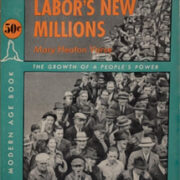Labor’s New Millions by Mary Heaton Vorse
The epub format below is for your Apple and Android devices including Send-to-Kindle.
As you may know, Amazon has changed to the epub format to use with the Send-to-Kindle program. A great feature of the Send-to-Kindle program is that the file will go directly to your Library folder, and not have to be searched for in ES File Explorer or another app. If you use the mobi format in Send-to-Kindle, you will now get an error message. You can see instructions about Send to Kindle at https://www.amazon.com/gp/sendtokindle/email.
If you or your students want to download directly from this website to an Amazon device, you can use the mobi format below. When you find the mobi file in ES File Explorer, it will then open in the Kindle app on your tablet. If you download an epub file to your Amazon tablet, it will also open if you have an app such as Overdrive on your tablet. The Kindle app offers an excellent reading experience to start with. Overdrive may need some customization of font size.
Download mobi file here.
This is the story of how labor unions used sitdown strikes to force automakers and steelmakers into contracts that provided living wages for millions of American workers at the midcentury. The reading level is 9.1.
“How this young union whirled its membership from 30,000 to 400,000 in a year is one of labor’s greatest epics,” wrote Mary Heaton Vorse in Labor’s New Millions referring to the United Auto Workers. “In some places, wages increased from thirty and forty cents to one dollar an hour. Much had been done to set up healthier working conditions in the industry.” In Labor’s New Millions, Vorse explained how workers in the rubber plants, and steel mills and auto plants used sit-ins to force management to recognize their unions and then negotiate with the new unions. By the time of Labor’s New Millions, she had written about earlier labor struggles in national publications such as Harper’s and The Nation, and published novels and short stories about domestic relationships and family life. Her experience as a writer shows. Your students will see that she reported on the labor-management conflicts of mid-century with energy and enthusiasm. After the organizing of the 1930s and 1940s, one-third of American workers were union members in the 1950s. Today the number is 10%.
Vorse’s background as a writer is interesting. A historian wrote that it was a textile strike in Massachusetts that pushed Mary Heaton Vorse into writing about labor. “…Yet it was the 1912 textile workers’ strike in Lawrence, Massachusetts, that she would name in her 1934 autobiography as the turning point. For the rest of her life, until her death in 1966 at the age of ninety-two, workers’ battles for fair treatment would be her primary focus. “We knew now where we belonged;” she wrote, “on the side of the workers, and not with the comfortable people among whom we were born.”
“The conditions in the mills at Lawrence are still shocking. At the turn of the century, workers, many of them teenagers, scraped by on two or three dollars a week, most of which went to paying their rent in overcrowded districts. Women were subject to routine sexual exploitation by their bosses, and death from accidents or lung diseases were everyday occurrences. Thirty-six out of every hundred men and women who worked the mills died before the age of twenty-five. In early 1912, the state attempted to enforce a law cutting the hours of the women and those under eighteen in the mills to fifty-four hours a week. In response, the mill owners cut everyone’s hours and their salaries, and were accused of speeding up output.” See more about Vorse’s life at https://www.theparisreview.org/blog/2019/11/25/feminize-your-canon-mary-heaton-vorse/




Leave a Reply
Want to join the discussion?Feel free to contribute!